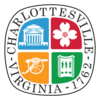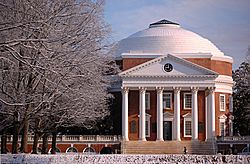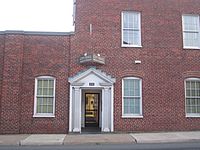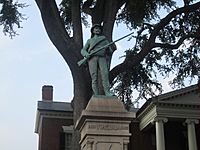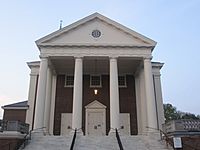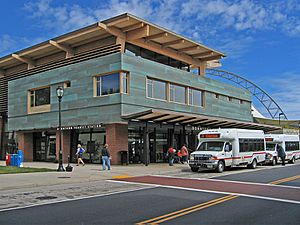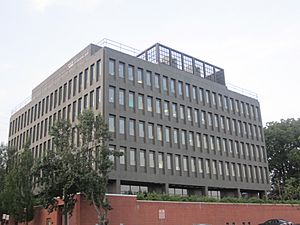Charlottesville, Virginia facts for kids
Quick facts for kids
Charlottesville, Virginia
|
||
|---|---|---|
| City of Charlottesville | ||
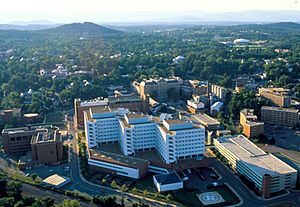
Charlottesville skyline with the University of Virginia Health System in the foreground
|
||
|
||
| Nicknames:
C'ville, Hoo-Ville
|
||
| Motto(s):
A great place to live for all of our citizens.
|
||
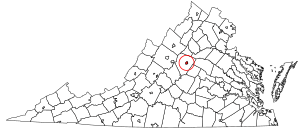
Location in the Commonwealth of Virginia
|
||
| Country | United States | |
| State | Virginia | |
| County | None (Independent city) | |
| Founded | 1762 | |
| Named for | Charlotte of Mecklenburg-Strelitz | |
| Government | ||
| • Type | Mayor–council government | |
| Area | ||
| • Independent city | 10.27 sq mi (26.60 km2) | |
| • Land | 10.25 sq mi (26.55 km2) | |
| • Water | 0.02 sq mi (0.05 km2) | |
| Elevation | 594 ft (181 m) | |
| Population
(2020)
|
||
| • Independent city | 46,553 | |
| • Density | 4,541.76/sq mi (1,753.41/km2) | |
| • Metro | 221,524 (209th) | |
| Demonym(s) | Charlottesvillian | |
| Time zone | UTC−5 (EST) | |
| • Summer (DST) | UTC−4 (EDT) | |
| ZIP Codes |
22901–22908
|
|
| Area code(s) | 434 | |
| FIPS code | 51-14968 | |
| GNIS feature ID | 1498463 | |
| Major Roadways | ||
| Waterways | Rivanna River | |
| Public Transit | Charlottesville Area Transit, University Transit Service, JAUNT | |
| Rail Service | Cardinal, Crescent, Northeast Regional | |
| Airport | Charlottesville-Albemarle | |
Charlottesville, colloquially known as C'ville, is an independent city in the Commonwealth of Virginia. It is the county seat of Albemarle County, which surrounds the city, though the two are separate legal entities. It is named after Queen Charlotte. As of the 2020 census, the population was 46,553. The Bureau of Economic Analysis combines the City of Charlottesville with Albemarle County for statistical purposes, bringing its population to approximately 150,000. Charlottesville is the heart of the Charlottesville metropolitan area, which includes Albemarle, Buckingham, Fluvanna, Greene, and Nelson counties.
Charlottesville was the home of two presidents, Thomas Jefferson and James Monroe. During their terms as Governor of Virginia, they lived in Charlottesville, and traveled to and from Richmond, along the 71-mile (114 km) historic Three Notch'd Road. Orange, located 26 miles (42 km) northeast of the city, was the hometown of President James Madison. The University of Virginia, founded by Jefferson, straddles the city's southwestern border. Jefferson's home, Monticello, 3 miles (5 km) southeast of the city, is, along with the University of Virginia, a UNESCO World Heritage Site, attracting thousands of tourists every year.
Contents
History
At the time of European encounter, part of the area that became Charlottesville was occupied by a Monacan village called Monasukapanough.
Charlottesville was formed in 1762 by an Act of the Assembly of Albemarle County. Thomas Walker was named its first trustee. It was along a trade route called Three Notched Road (present day U.S. Route 250) which led from Richmond to the Great Valley. It was named for Charlotte of Mecklenburg-Strelitz, queen consort of the United Kingdom as the wife of King George III.
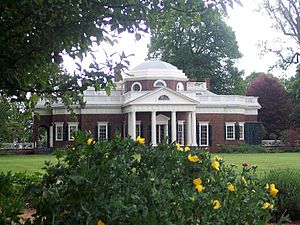
During the American Revolutionary War, the Convention Army was imprisoned in Charlottesville between 1779 and 1781 at the Albemarle Barracks. The Governor and legislators had to temporarily abandon the capitol and on June 4, 1781, Jack Jouett warned the Virginia Legislature meeting at Monticello of an intended raid by Banastre Tarleton, allowing a narrow escape.
Unlike much of Virginia, Charlottesville was spared the brunt of the American Civil War. The only battle to take place in Charlottesville was the skirmish at Rio Hill, an encounter in which George Armstrong Custer briefly engaged local Confederate home guards before he retreated. The mayor surrendered the city to Custer's men to keep the town from being burned. The Charlottesville Factory, founded ca. 1820–30, was accidentally burnt during General Sheridan's 1865 raid through the Shenandoah Valley. The factory had been taken over by the Confederacy and used to manufacture woollen clothing for the soldiers. It caught fire when some coals taken by Union troops to burn the nearby railroad bridge had been dropped on the floor. The factory was rebuilt immediately and was known as the Woolen Mills until its liquidation in 1962.
The first black church in Charlottesville was established in 1864. Previously, it was illegal for African-Americans to have their own churches, although they could worship in white churches. A current predominantly African-American church can trace its lineage to that first church. Congregation Beth Israel's 1882 building is the oldest synagogue building still standing in Virginia.
In the fall of 1958, Charlottesville closed its segregated white schools as part of Virginia's strategy of massive resistance to federal court orders requiring integration as part of the implementation of the Supreme Court of the United States decision Brown v. Board of Education. The closures were required by a series of state laws collectively known as the Stanley plan. Negro schools remained open, however.
Charlottesville is the home of the National Radio Astronomy Observatory headquarters, the Leander McCormick Observatory and the CFA Institute. It is served by two area hospitals, the Martha Jefferson Hospital founded in 1903, and the University of Virginia Hospital.
The National Ground Intelligence Center (NGIC) is in the Charlottesville area. Other large employers include Crutchfield, GE Intelligent Platforms, PepsiCo and SNL Financial.
Geography
According to the United States Census Bureau, the city has a total area of 10.3 square miles (27 km2), virtually all of which is land.
Charlottesville is located in the center of the Commonwealth of Virginia along the Rivanna River, a tributary of the James, just west of the Southwest Mountains, itself paralleling the Blue Ridge about 20 miles (32 km) to the west.
Charlottesville is 115 miles (185 km) from Washington, D.C. and 70 miles (110 km) from Richmond.
Climate
Charlottesville has a four-season humid subtropical climate (Köppen Cfa), with all months being well-watered, though the period from May to September is the wettest. Winters are somewhat cool, with a January average of 35.9 °F (2.2 °C), though lows can fall into the teens (< −7 °C) on some nights and highs frequently (11 days in January) reach 50 °F (10 °C). Spring and autumn provide transitions of reasonable length. Summers are hot and humid, with July averaging 77.2 °F (25.1 °C) and the high exceeding 90 °F (32 °C) on 33 or more days per year. Snowfall is highly variable from year to year but is normally light, averaging 17.3 inches (44 cm). What does fall does not remain on the ground for long. Extremes have ranged from −10 °F (−23 °C) on January 19, 1994 up to 114 °F (46 °C), most recently on September 7, 1954.
| Climate data for Charlottesville, Virginia (1981–2010 normals) | |||||||||||||
|---|---|---|---|---|---|---|---|---|---|---|---|---|---|
| Month | Jan | Feb | Mar | Apr | May | Jun | Jul | Aug | Sep | Oct | Nov | Dec | Year |
| Average high °F (°C) | 45.2 (7.3) |
49.2 (9.6) |
57.6 (14.2) |
68.7 (20.4) |
75.7 (24.3) |
84.0 (28.9) |
87.5 (30.8) |
86.0 (30.0) |
79.3 (26.3) |
68.9 (20.5) |
59.0 (15.0) |
47.8 (8.8) |
67.4 (19.7) |
| Average low °F (°C) | 26.6 (−3.0) |
29.0 (−1.7) |
36.0 (2.2) |
45.6 (7.6) |
54.4 (12.4) |
63.2 (17.3) |
66.9 (19.4) |
65.4 (18.6) |
58.3 (14.6) |
47.8 (8.8) |
38.8 (3.8) |
29.9 (−1.2) |
46.8 (8.2) |
| Average precipitation inches (mm) | 3.10 (79) |
3.18 (81) |
3.89 (99) |
3.34 (85) |
4.56 (116) |
4.16 (106) |
5.31 (135) |
4.04 (103) |
4.89 (124) |
3.81 (97) |
4.01 (102) |
3.31 (84) |
47.61 (1,209) |
| Average snowfall inches (cm) | 4.6 (12) |
5.7 (14) |
2.1 (5.3) |
.1 (0.25) |
0 (0) |
0 (0) |
0 (0) |
0 (0) |
0 (0) |
0 (0) |
.5 (1.3) |
4.2 (11) |
17.3 (44) |
| Average precipitation days (≥ 0.01 in) | 9.2 | 9.3 | 10.7 | 11.3 | 12.6 | 10.6 | 12.2 | 11.1 | 9.7 | 8.3 | 8.9 | 9.6 | 123.6 |
| Average snowy days (≥ 0.1 in) | 2.1 | 2.2 | .8 | .1 | 0 | 0 | 0 | 0 | 0 | 0 | .3 | 1.5 | 7.0 |
| Source: NOAA | |||||||||||||
Attractions and culture
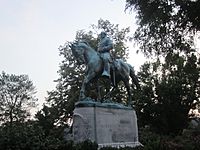
Charlottesville has a large series of attractions and venues for its relatively small size. Visitors come to the area for wine and beer tours, ballooning, hiking, and world-class entertainment that perform at one of the area's four larger venues. The city is both the launching pad and home of the Dave Matthews Band as well as the center of a sizable indie music scene.
The Charlottesville area was the home of Thomas Jefferson, James Madison, and James Monroe. Monticello, Jefferson's plantation manor, is located just a few miles from downtown. The home of James Monroe, Ash Lawn-Highland, is down the road from Monticello. About 25 miles (40 km) northeast of Charlottesville lies the home of James and Dolley Madison, Montpelier. During the summer, the Ash Lawn-Highland Opera Festival is held at the downtown Paramount Theater with a performance at Ash Lawn-Highland.
The nearby Shenandoah National Park offers recreational activities and beautiful scenery, with rolling mountains and many hiking trails. Skyline Drive is a scenic drive that runs the length of the park, alternately winding through thick forest and emerging upon sweeping scenic overlooks. The Blue Ridge Parkway, a similar scenic drive that extends 469 miles (755 km) south to Great Smoky Mountains National Park in North Carolina, terminates at the southern entrance of Shenandoah, where it turns into Skyline Drive. This junction of the two scenic drives is only 22 miles (35 km) west of downtown Charlottesville.
Charlottesville's downtown is a center of business for Albemarle County. It is home to the Downtown Mall, one of the longest outdoor pedestrian malls in the nation, with stores, restaurants, and civic attractions. The renovated Paramount Theater hosts various events, including Broadway shows and concerts. Local theatrics downtown include Charlottesville's community theater Live Arts. Outside downtown are the New Lyric Theatre and Heritage Repertory Theatre at UVa. Other attractions on the Downtown Mall are the Virginia Discovery Museum and a 3,500 seat outdoor amphitheater, the Sprint Pavilion (formerly the nTelos Wireless Pavilion). Court Square, just a few blocks from the Downtown Mall, is the original center of Charlottesville and several of the historic buildings there date back to the city's founding in 1762.
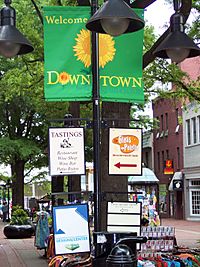
Charlottesville also is home to the University of Virginia (most of which is legally in Albemarle County). During the academic year more than 20,000 students pour into Charlottesville to attend the university. Its main grounds are located on the west side of Charlottesville, with Thomas Jefferson's Academical Village, known as the Lawn, as the centerpiece. The Lawn is a long esplanade crowned by two prominent structures, The Rotunda (designed by Jefferson) and Old Cabell Hall (designed by Stanford White). Along the Lawn and the parallel Range are dormitory rooms reserved for distinguished students. The University Programs Council is a student-run body that programs concerts, comedy shows, speakers, and other events open to the students and the community, such as the annual "Lighting of the Lawn". One block from The Rotunda, the University of Virginia Art Museum exhibits work drawn from its collection of more than 10,000 objects and special temporary exhibitions from sources nationwide. It is also home to the Judge Advocate General's Legal Center and School where all U.S. Army military lawyers, known as "JAGs", take courses specific to military law.
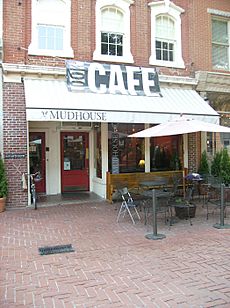
The Corner is the commercial district abutting the main grounds of UVa, along University Avenue. This area is full of college bars, eateries, and UVa merchandise stores, and is busy with student activity during the school year. Pedestrian traffic peaks during UVa home football games and graduation ceremonies. Much of the University's Greek life is on nearby Rugby Road, contributing to the nightlife and local bar scene. West Main Street, running from the Corner to the Downtown Mall, is a commercial district of restaurants, bars, and other businesses.
Charlottesville is host to the annual Virginia Film Festival in October, the Charlottesville Festival of the Photograph in June, and the Virginia Festival of the Book in March. In addition, the Foxfield Races are steeplechase races held in April and September of each year. A Fourth of July celebration, including a Naturalization Ceremony, is held annually at Monticello, and a First Night celebration has been held on the Downtown Mall since 1982.
Infrastructure
Transportation
Roads and highways
The most significant highways passing through Charlottesville are Interstate 64, U.S. Route 29 and U.S. Route 39. I-64 heads east to Interstate 95 in Richmond and west to Interstate 81 in Staunton. US 29 heads southwest towards Lynchburg and northeast to Washington, D.C. Other highways serving Charlottesville include U.S. Route 250 and Virginia State Route 20. US 29 and US 250 are served locally by bypasses around downtown, with business routes passing directly through downtown.
Public transportation
Charlottesville is served by Charlottesville-Albemarle Airport, the Charlottesville Amtrak Station, and a Greyhound Lines intercity bus terminal. Direct bus service to New York City is also provided by the Starlight Express. Charlottesville Area Transit provides area bus service, augmented by JAUNT, a regional paratransit van service. University Transit Service provides mass transit for students and residents in the vicinity of the University of Virginia.
Rail
Amtrak, the national passenger rail service, provides service to Charlottesville with three routes: The Cardinal (service between Chicago and New York City via central Virginia and Washington, D.C.), select Northeast Regional trains (service between Boston and Roanoke) and the Crescent (service between New York City and New Orleans). The Cardinal operates three times a week, while the Crescent and Northeast Regional both run daily in both directions.
Charlottesville was once a major rail hub, served by both the Chesapeake and Ohio Railway (C&O) and the Southern Railway. The first train service to Charlottesville began in the early 1850s by the Louisa Railroad Company, which became the Virginia Central Railroad before becoming the C&O. The Southern Railway started service to Charlottesville around the mid-1860s with a north–south route crossing the C&O east-west tracks. The new depot that sprang up at the crossing of the two tracks was called Union Station. In addition to the new rail line, Southern located a major repair shop that produced competition between the two rail companies and bolstered the local economy. The Queen Charlotte Hotel went up on West Main street along with restaurants for the many new railroad workers.
The former C&O station on East Water Street was turned into offices in the mid-1990s. Charlottesville Union Station, still a functional depot for Amtrak, is located on West Main street between 7th and 9th streets where the tracks of the former C&O Railway (leased by C&O successor CSX to Buckingham Branch Railroad) and Southern (now Norfolk Southern Railway) lines cross. Amtrak and the city of Charlottesville finished refurbishing the station just after 2000, upgrading the depot and adding a full-service restaurant. The Amtrak Crescent travels on Norfolk Southern's dual north–south tracks. The Amtrak Cardinal runs on the Buckingham Branch east-west single track, which follows U.S. Route 250 from Staunton to a point east of Charlottesville near Cismont. The eastbound Cardinal joins the northbound Norfolk Southern line at Orange, on its way to Washington, D.C.
Charlottesville also had an electric streetcar line, the Charlottesville and Albemarle Railway (C&A), that operated during the early twentieth century. Streetcar lines existed in Charlottesville since the late 1880s under various names until organized as the C&A in 1903. The C&A operated streetcars until 1935, when the line shut down due to rising costs and decreased ridership.
There are proposals to extend Virginia Railway Express, the commuter rail line connecting Northern Virginia to Washington, D.C., to Charlottesville. Also, the Transdominion Express steering committee has suggested making Charlottesville a stop on the proposed statewide passenger rail line.
Demographics
| Historical population | |||
|---|---|---|---|
| Census | Pop. | %± | |
| 1870 | 2,838 | — | |
| 1880 | 2,676 | −5.7% | |
| 1890 | 5,591 | 108.9% | |
| 1900 | 6,449 | 15.3% | |
| 1910 | 6,765 | 4.9% | |
| 1920 | 10,688 | 58.0% | |
| 1930 | 15,245 | 42.6% | |
| 1940 | 19,400 | 27.3% | |
| 1950 | 25,969 | 33.9% | |
| 1960 | 29,427 | 13.3% | |
| 1970 | 38,880 | 32.1% | |
| 1980 | 39,916 | 2.7% | |
| 1990 | 40,341 | 1.1% | |
| 2000 | 40,099 | −0.6% | |
| 2010 | 43,475 | 8.4% | |
| 2020 | 46,553 | 7.1% | |
| U.S. Decennial Census 1790–1960 1900–1990 1990–2000 2010–2015 2020 |
|||
2020 census
| Race / Ethnicity | Pop 2010 | Pop 2020 | % 2010 | % 2020 |
|---|---|---|---|---|
| White alone (NH) | 28,827 | 29,609 | 66.31% | 63.60% |
| Black or African American alone (NH) | 8,344 | 7,030 | 19.19% | 15.10% |
| Native American or Alaska Native alone (NH) | 65 | 66 | 0.15% | 0.14% |
| Asian alone (NH) | 2,758 | 4,064 | 6.34% | 8.73% |
| Pacific Islander alone (NH) | 13 | 18 | 0.03% | 0.04% |
| Some Other Race alone (NH) | 89 | 218 | 0.20% | 0.47% |
| Mixed Race/Multi-Racial (NH) | 1,156 | 2,341 | 2.66% | 5.03% |
| Hispanic or Latino (any race) | 2,223 | 3,207 | 5.11% | 6.89% |
| Total | 43,475 | 46,553 | 100.00% | 100.00% |
Note: the US Census treats Hispanic/Latino as an ethnic category. This table excludes Latinos from the racial categories and assigns them to a separate category. Hispanics/Latinos can be of any race.
2010 Census
As of the census of 2010, there were 43,475 people, 17,778 households, and 7,518 families residing in the city. The population density was 4,220.8 people per square mile (1,629.5/km2). There were 19,189 housing units. The racial makeup of the city was 69.1% White, 19.4% Black American, 0.3% Native American, 6.4% Asian, 1.8% from other races, and 3.0% from two or more races. 5.1% of the population were Hispanics or Latinos of any race.
There were 17,778 households, out of which 17.9% had children under the age of 18 living with them, 28.1% were married couples living together, 11.3% had a female householder with no husband present, and 57.7% were non-families. 34.1% of all households were made up of individuals, and 7.5% had someone living alone who was 65 years of age or older. The average household size was 2.31 and the average family size was 2.91.
The age distribution was 14.9% under the age of 18, 24.3% from 18 to 24, 28.9% from 25 to 44, 18.8% from 45 to 64, and 9.2% who were 65 years of age or older. The median age was 27.8 years. The population was 52.3% female and 47.7% male. The city's low median age and the "bulge" in the 18-to-24 age group are both due to the presence of the University of Virginia.
The median income for a household in the city was $44,535, and the median income for a family was $63,934. The per capita income for the city was $26,049. About 10.5% of families and 27.3% of the population were below the poverty line, including 15.8% of those under age 18 and 7.9% of those age 65 or over.
20% of Charlottesville residents have a graduate or professional degree, compared with 10% in the United States as a whole.
Federally, Charlottesville is part of Virginia's 5th congressional district, represented by Republican Bob Good, elected in 2020.
Sister cities
Charlottesville has four sister cities:
Economy
Charlottesville is the home of the National Radio Astronomy Observatory headquarters, the Leander McCormick Observatory and the CFA Institute. It is served by two area hospitals, the Martha Jefferson Hospital founded in 1903, and the University of Virginia Hospital. The National Ground Intelligence Center (NGIC) is in the Charlottesville area. Other large employers include Crutchfield, Emerson Automation Solutions, PepsiCo and SNL Financial.
18% of people employed in Charlottesville live there, while 82% commute into the city. 42% of those commuting to Charlottesville live in Albemarle County. Additionally, 11,497 people commute from Charlottesville outside of the city for employment. 51% of those commuting from Charlottesville work in Albemarle County. In 2016, Charlottesville had a 3.3% unemployment rate.
Largest employers
According to the City's 2019 Comprehensive Annual Financial Report the largest employers in the city are:
| # | Employer | # of employees |
|---|---|---|
| 1 | University of Virginia Medical Center | 1,000+ |
| 2 | City of Charlottesville | 1,000+ |
| 3 | UVA Health Services Foundation | 1,000+ |
| 4 | Charlottesville City School Board | 500–999 |
| 5 | Servicelink Management Com Inc | 500–999 |
| 6 | Aramark Campus LLC | 500–999 |
| 7 | WorldStrides (Lakeland Tours) | 500–999 |
| 8 | Association for Investment Management | 250-499 |
| 9 | Rmc Events | 250-499 |
| 10 | Crutchfield Corporation | 250–499 |
As of 2016, 11,129 people work for the government, with 376 working for the federal government, 7,796 working for the state government, and 2,957 working for the local government.
Breweries
Charlottesville has nine breweries within or near its city limits: South Street Brewery (owned by Blue Mountain Brewery), Champion Brewing Company, Three Notch'd Brewing Company, Random Row Brewing Company, Rockfish Brewing Company, Wild Wolf Brewing Company, Pro Re Nata Brewery, Reason Beer (Albemarle), and Decipher Brewing (Albemarle). The first brewery in the City was Blue Ridge Brewery, located on West Main Street, and was owned and managed by grandchildren of writer William Faulkner. Starr Hill Brewery was originally based in Charlottesville but is today located in Crozet, Virginia, 13 miles west of the city.
Sports
Charlottesville has no professional sports teams, but is home to the University of Virginia's athletic teams, the Cavaliers, most notably the 2019 NCAA Men's National Basketball Champions. The Cavaliers have a wide fan base throughout the region. The Cavaliers field teams in sports from soccer to basketball, and have modern facilities that draw spectators throughout the year. Cavalier football season draws the largest crowds during the academic year, with football games played in Scott Stadium. The stadium hosted large musical events, including concerts by the Dave Matthews Band, The Rolling Stones and U2.
John Paul Jones Arena, which opened in 2006, is the home arena of the Cavalier basketball teams, in addition to serving as a site for concerts and other events. The arena seats 14,593 for basketball. In its first season in the new arena concluded in March 2007, the Virginia men's basketball team tied with UNC for 1st in the ACC. Virginia Cavaliers men's basketball won the ACC outright in the 2013–14 season, as well as the 2014 ACC Tournament. The team finished the season ranked #3 in the AP poll before losing to Tom Izzo's Spartans by two points in the Sweet Sixteen held in Brooklyn, New York. The Cavaliers' men's basketball team won the NCAA championship in April, 2019.
Lacrosse has become a significant part of the Charlottesville sports scene. The Virginia Men's team won their first NCAA Championship in 1972; in 2006, they won their fourth National Championship and were the first team to finish undefeated in 17 games (then a record for wins). The team won its seventh National Championship in 2021. Virginia's Women's team has three NCAA Championships to its credit, with wins in 1991, 1993, and 2004. The soccer program is also strong; the Men's team shared a national title with Santa Clara in 1989 and won an unprecedented four consecutive NCAA Division I Championships (1991–1994). Their coach during that period was Bruce Arena, who later won two MLS titles at D.C. United and coached the U.S. National Team during the 2002 and 2006 World Cups. The Virginia Men's soccer team won the NCAA Championship again in both 2009 and 2014 under coach George Gelnovatch. Virginia's baseball team, has enjoyed a resurgence in recent years, under Head Coach Brian O'Connor, after hosting several regionals and Super Regionals in the post-season, and playing in the 2009, 2011, and 2014 College World Series. They finished as runners-up in the 2014 edition, despite outscoring Vanderbilt 17–12 in the three-game series. The team then avenged this loss the following year, beating Vanderbilt in 2015 for its first NCAA baseball title.
Charlottesville area high school sports have been prominent throughout the state. Charlottesville is a hotbed for lacrosse in the country, with teams such as St. Anne's-Belfield School, The Covenant School, Tandem Friends School, Charlottesville Catholic School, Charlottesville High School, Western Albemarle High School and Albemarle High School. Charlottesville High School won the VHSL Group AA boys' soccer championship in 2004. St. Anne's-Belfield School won its fourth state private-school championship in ten years in football in 2006. The Covenant School won the state private-school title in boys' cross country in the 2007–2008 school year, the second win in as many years, and that year the girls' cross country team won the state title. Monticello High School won the VHSL Group AA state football title in 2007. Charlottesville High School's boys' soccer team were state champs again in 2019, when it won the VHSL Class 4A Championship.
Charlottesville is also home to the Charlottesville Tom Sox of the Valley Baseball League who won the 2017 & 2019 league championships. Their home stadium is Crutchfield Park at Charlottesville High School. Charlottesville is also home to the Charlottesville Alliance FC, a soccer team who compete in the NPSL.
Education
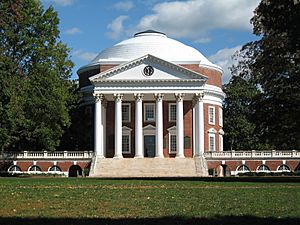
The University of Virginia, one of the original Public Ivies, is located in the City of Charlottesville and the County of Albemarle.
Piedmont Virginia Community College maintains several locations in Charlottesville.
Charlottesville is served by the Charlottesville City Public Schools. The school system operates six elementary schools, Walker Upper Elementary School, Buford Middle School and Charlottesville High School. It operated Lane High School jointly with Albemarle County from 1940–1974, when it was replaced by Charlottesville High School. Jackson P. Burley High School, a segregated school for African American students, was in operation from 1951-1967 and served students from both the City of Charlottesville and Albemarle County. Burley High School was purchased by Albemarle County soon after it closed, and reopened in 1974 as Jackson P. Burley Middle School.
Albemarle County Public Schools, which serves nearby Albemarle County, has its headquarters in Charlottesville.
Charlottesville also has the following private schools, some attended by students from Albemarle County and surrounding areas:
- Charlottesville Waldorf School
- The Covenant School (Lower campus)
- Regents School of Charlottesville
- Renaissance School
- St. Anne's-Belfield School (Greenway Rise campus)
- Village School
- The Virginia Institute of Autism
- Peabody School
City children also attend several private schools in the surrounding county. Those with Charlottesville postal addresses include:
- Charlottesville Catholic School
- The Covenant School (Hickory campus)
- Tandem Friends School
Jefferson-Madison Regional Library is the regional library system that provides services to the citizens of Charlottesville.
Notable people
The city was also home of the Tibetan lama Tenzin Wangyal Rinpoche, but he and his family have since moved to California. His Ligmincha Institute headquarters, Serenity Ridge, is in nearby Shipman, Virginia.
See also
 In Spanish: Charlottesville (Virginia) para niños
In Spanish: Charlottesville (Virginia) para niños


